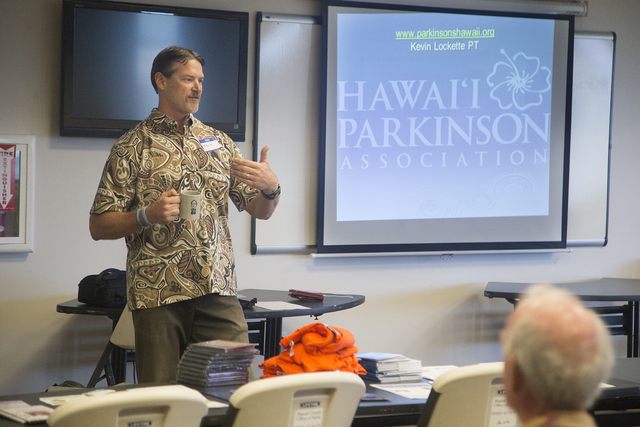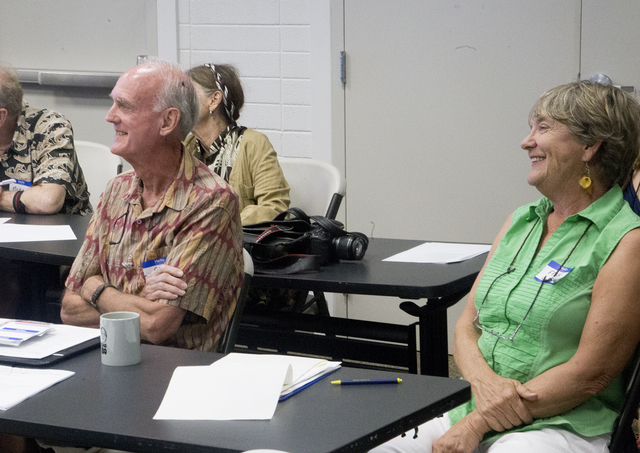What comes after a diagnosis?
It’s a question many people who live with chronic disease face, and one that doesn’t always have a straightforward answer. Doctor appointments can address physical symptoms, but can only go so far to create a feeling of support.
It’s often helpful just to know you’re not alone.
That’s the goal of the Hilo Parkinson’s Support Group, which held its first meeting Friday afternoon and was attended by more than 30 people. The group is for those who have Parkinson’s disease as well as caretakers.
Hawaiian Paradise Park resident Fran Calvert decided to revive the Hilo group, which had gone dormant when its original facilitator passed away, after husband Glen received a Parkinson’s diagnosis about a year and a half ago.
The couple tried
to gather as much information as possible, but felt there was more to know.
“We spent a year and a half not getting information you should have,” Calvert explained. “I know that gathering and just sharing what’s working for us — that’ll be really helpful.”
She said she plans to bring speakers in as often as possible to share new research and strategies for managing Parkinson’s.
Kevin Lockette, board president of the Kailua, Oahu-based nonprofit Hawaii Parkinson’s Association, spoke at Friday’s meeting. Lockette is a physical therapist and said that over the past 14 years about 90 percent of his patients had Parkinson’s.
The Hawaii Parkinson’s Association efforts focus exclusively on the islands, and Lockette said that year one of the group’s goals was to increase its reach beyond Oahu.
“We’re trying to fill the gaps on the Neighbor Islands,” he said. “Let us know what your needs are.”
Parkinson’s disease is a neurological disorder that affects movement. For many, its most recognizable face is that of actor Michael J. Fox, who was diagnosed at a young age.
About one in 100 Americans over the age of 60 has Parkinson’s. It develops over time, and early symptoms are not always recognizable. Some symptoms include resting tremors, stiffness, and slowed movements.
Parkinson’s affects the part of the brain that is responsible for automatic movement, Lockette said. A key part of physical therapy for patients focuses on purposeful movement, which does not come naturally to humans.
“We’re not wired to think about movement; we just move,” Lockette said, adding that exercise is an important part of managing Parkinson’s because it is a neuroproductive activity.
But the disease is not cookie-cutter, and those affected will present the disorder in different ways.
“If you’ve met one person with Parkinson’s … you’ve met one person with Parkinson’s,” Lockette said. That makes support groups a valuable resource for comparing notes.
“It’s a big part of dealing with the disease,” he said after his presentation.
There are other support groups around the island, including those in Puna and Waimea. Paul and Diane Steed of Hakalau also participate in Waimea’s group, which is smaller than Hilo’s and focuses mainly on dance and exercise.
The Steeds had attended other support groups before, when Diane had thyroid cancer, so when Paul received a Parkinson’s diagnosis they knew how valuable the groups could be.
“It’s more information than just the doctors can (give),” Diane Steed said.
The Hilo Parkinson’s support group meets the last Friday of each month at 2 p.m. at the Office of Aging.
Email Ivy Ashe at iashe@hawaiitribune-herald.com.









